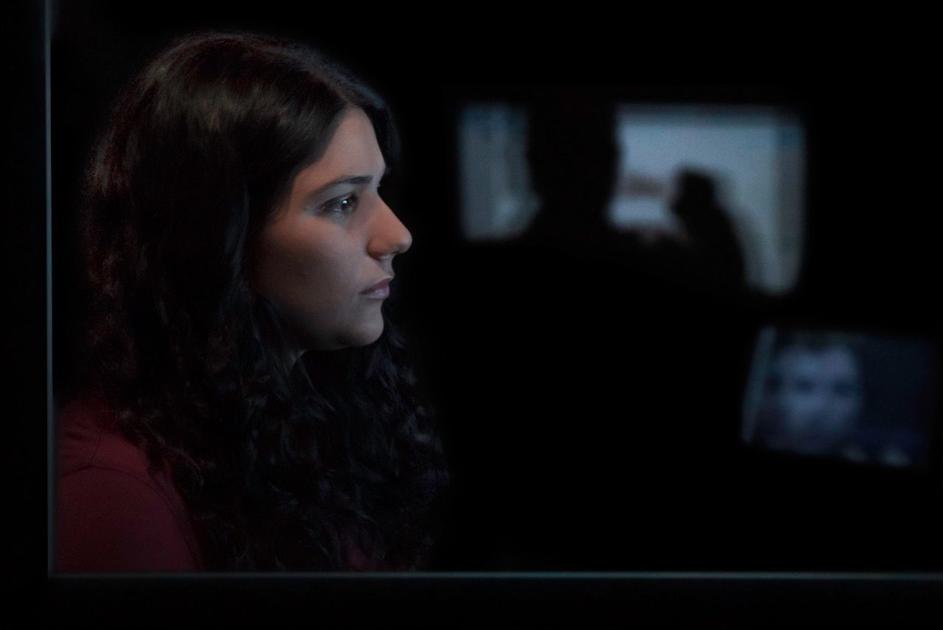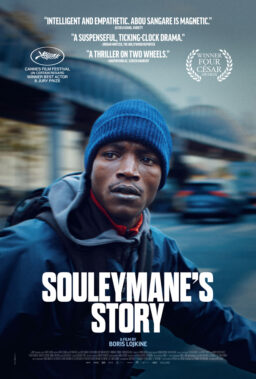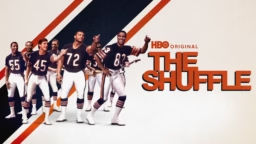There’s no beating around the bush: this year’s True/False Film Festival happened a week before the World Health Organization declared the Coronavirus outbreak to be a pandemic. There was plenty of anxious discussion about the rampant spread of the disease on the ground, concerned talk about how it would affect our lives in the near future, all a prelude to the temporary shutdown of normal life in the United States that would occur in just a few short days. Now, it’s almost impossible to view this year’s True/False through any other lens. Films were discussed, but once SXSW announced its official cancellation on the Friday of the festival, it was a slow march to this very moment of social distancing, self-isolation, and the rapid discontinuation of this country’s artistic infrastructure, including but not limited to theatrical exhibition.
It would be pointless to try to force any other connective theme to this year’s offerings. The best of the lot reflects our modern world in all of its beauty and misery. Still, it genuinely feels like True/False was the last calm before the storm, and, honestly, it didn’t feel that calm. The annual non-fiction film festival usually functions like a respite from the pressures of daily life, but this year, through no fault of its own, it wasn’t strong enough to keep them away. The world trickled in through the proverbial dam, and then the dam collapsed.
Here is the first of three dispatches about some of the films I saw at this year’s festival.
Ra’anan Alexandrowicz’s “The Viewing Booth” employs a compelling interrogative method to reach a fairly obvious conclusion about the deep-seated roots of ideology. In the film, Alexandrowicz invites Maia Levy, a college student, into a media lab to watch videos of life in the West Bank and articulate her thoughts. Some of the videos are from the organization B’Tselem, which tries to spotlight human rights violations in the Occupied Palestinian Territories, and others are from pro-IDF advocacy groups, but Maia mostly watches the B’Tselem videos. Alexandrowicz records her via the computer’s front-facing camera as she watches and speaks about the videos. Maia then returns to the lab six months later to watch herself watch the videos and comment upon her initial reactions.
Alexandrowicz has previously employed confrontational staging in the search for redress. In his award-winning 2011 film “The Law in These Parts,” he brings together architects of the post-’67 legal system in the Occupied Palestinian Territories into a studio space with a green screen backdrop to interrogate them about how their laws were used to oppress while images of said oppression play behind them. “The Viewing Booth” takes a slightly gentler approach with Maia, a fervid supporter of Israel, but Alexandrowicz still has no compunction with letting her hang herself with her own words. As Maia watches video of human rights abuses at the hands of the Israeli military, she constantly tries to poke holes in the images. She wonders aloud if they’re staged or ponders the larger context of the videos, refusing to believe that the oppression she witnesses is the whole truth. One lengthy sequence features Maia watching Israeli soldiers search a home in the middle of the night and demand two parents wake their young children so they can be questioned. Maia doesn’t focus on the privacy violation or the traumatic gestures. Instead, she tries to figure out whether the children are faking their distress.
Though Alexandrowicz tells Maia she’s not part of any experiment, he’s still using her as a test subject to examine whether images can challenge or test one’s beliefs. Alexandrowicz doesn’t want to preach to the converted, he wants to use cinema to change minds, but “The Viewing Booth” essentially illustrates that he’s embarked on a fool’s errand. Maia, who’s still young and impressionable and at least willing to engage with the B’Tselem videos, frequently misuses basic media literacy tools to circumvent or dampen any empathetic response that might challenge her ideology. Her attempts to suss out performativity or decontextualized images only superficially suggest viewer savviness, but her narration makes clear that she either doesn’t fully believe Palestinian anguish or fundamentally doesn’t care enough to try. At one point, Maia wonders why a child didn’t cry in front of Israeli soldiers invading his home but did so later in front of his parents after they had left, implicitly believing it to be coached. Alexandrowicz patiently explains to her that children in traumatic situations often keep it together in the moment only to fall apart in the immediate aftermath out of shock and fear. If a fully conscious twenty-something requires that explanation to believe footage of a single abuse of power, good luck trying to change their broader ideology.
Alexandrowicz characterizes this conclusion as a devastating blow to his belief that cinematic tools can be employed for advocacy. At this point, I think it’s a little naïve to believe that the right evidence will change ideologically obdurate people, especially if it requires them to completely alter their perception of fellow friends, family members, and countrymen. Maybe my cynicism during this past half-decade has wiped out any good will I have towards the idea of “converting the other side,” but it was painfully obvious to me early on that Maia would view the footage as confirmation of her preexisting beliefs, something that deeply unsettles Alexandrowicz. She pays bare-minimum anti-violence lip service and briefly questions the legitimacy of a pro-IDF video, but she isn’t morally galvanized by anything she sees. She remains skeptical and incredulous of obvious truths up until the bitter end, which, frankly, is a common occurrence in our living epistemological nightmare. “The Viewing Booth” works well as an infuriating portrait of denial, but less so as the missed opportunity for transformation that Alexandrowicz believes it to be.

Sometimes the best tactic for a non-fiction character portrait is to indirectly mete out information, if only to provide conventional material with a somewhat unconventional foundation. The first scene of “So Late So Soon” introduces us to a woman fiddling with an aerial art piece made out of string with a cow figurine in the middle that hangs across the range in her kitchen. She wants to change out one color string for another and calls her husband for assistance with holding the cow in place. They share a laugh about the crazy things he has watched her make over the years. Then, we see archival footage of the same woman enthusiastically teaching a group of children about the beauty and freedom of artistic space. After that, we cut back to the present and watch the same woman dance around her house to Sade’s “Smooth Operator.”
It’s only much later we find out that we’re watching Jackie and Don Seiden, an artist couple living in Chicago’s Rogers Park neighborhood who have been married for over 50 years. Jackie taught children’s art classes at the Art Institute of Chicago for many years and turned her home into a living art piece. Don worked in mixed-media sculptures; his life-sized rhinoceros sits in his front yard. But director Daniel Hymanson provides us the opportunity to organically absorb these details without unnecessary narrative prods in the side. His intimate connection to the Seiden’s (Hymanson has known Jackie since he was a child), coupled with their remarkable comfort in front of the camera, gives him space to lead with character instead of introductions. Almost everything about the relationship, the shadow of their past, and the troubles that lie ahead exist in those opening three scenes without any additional context.
In “So Late So Soon,” Jackie and Don struggle with bodily deterioration and how that impacts the quality of life for their remaining years. There’s a neat thematic overlap between Jackie using everyday materials with built-in fragility for her art and her anxieties about aging, but Hymanson doesn’t push that idea front and center. He’s more concerned with how a lifetime couple buckles under the strain of the inevitable. Jackie’s debilitating arthritis slows down what was once a physically active woman and Don eventually suffers fainting spells that land him in the hospital. They both lead creative lives that inevitably demand mental and physical acuity, even at their late age, so any chronic physical insecurity has a major impact on their daily routine, but it also impacts the stability of their relationship. Jackie’s pain-related irritability makes her lash out at Don for not helping more around the house, which eventually spirals into her questioning their whole marriage. Watching Don, the otherwise more reserved member of the duo, passionately argue for the sustainability for their relationship is genuinely thrilling, if for no other reason than both are staring down the end of the line.
While Jackie and Don are funny and fascinating subjects on their own, Hymanson’s formal confidence elevates “So Late So Soon” to heights that the Seiden’s couldn’t reach by themselves. Rigorous compositions are mixed together with fly-on-the-wall footage that highlight performativity without feeling too stagey. The film moves in suites, each with its own focus, punctuated by archival footage that communicates the sheer breadth of their life and their work. Hymanson and editor Isidore Bethel demonstrate admirable restraint in not hitting any of its thematic points too directly, choosing instead to let the circadian rhythms of Jackie and Don’s routine communicate crucial ideas. It’s a heartfelt, yet unsentimental tribute to a life that resembles the Gesamtkunstwerk of their homestead: a beautiful, unusual synthesis of different practices and conflicting personalities that plan to go the distance.

Exhaustion can often be your best friend at True/False. It can help you surrender to abstract imagery instead of trying to interpret it in real time so that meaning becomes secondary to visual spectacle and editing rhythms. Unfortunately, this makes explaining why a film like “That Cloud Never Left” was so appealing in the moment. Director Yashaswini Raghunandan transports us to Daspara, an Indian village where people make toys out of discarded 35mm Bollywood film reels. Raghunandan provides little in the way of context outside of a couple title cards that strain for poetry, but instead lets the viewer discover through the manufacturing process that the texture of film stock generates either the color or sound for toys like rattles or windmills, not the images on them. Raghunandan brings some of the reels to life in psychedelic interstitial sequences projected onto the village environment. The material itself may be tossed and recycled, but Raghunandan protects its original use.
“That Cloud Never Left” occasionally falls into mawkish territory, especially when Raghunandan tries to weave brief stories through the film, like one involving children in search for a ruby. The film works best when it either indulges in psychedelic imagery, especially in scene transitions, or when it simply captures villagers performing their work or lying in rest. Raghunandan pierces his rural portrait with a gentle, semi-stoned rhythm that allows the viewer’s mind to wander but never too far off. Such abstraction works because it’s grounded in firm narrative foundation—the village eagerly anticipates an upcoming lunar eclipse—but Raghunandan rarely lets it thematically overwhelm the material. Plus, the title is a punchline that you’ll have to fully experience to understand.












